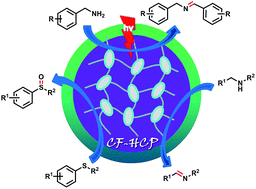Robust porous organic polymers as efficient heterogeneous organo-photocatalysts for aerobic oxidation reactions†
Abstract
Metal-free, visible-light active and heterogeneous organic photocatalysts offer a more sustainable and environmentally friendly alternative to traditional metal-based catalysts. Here a porous organic hyper-crosslinked polymer, CF-HCP, was successfully synthesized through a facile and cost-effective process. The chemical and structural properties of CF-HCP were fully characterized by using powder X-ray diffraction analysis, Fourier transform infrared spectroscopy, 13C solid-state NMR spectroscopy, electron microscopy, thermogravimetric analysis, X-ray photoelectron spectroscopy and nitrogen adsorption. The new three-dimensional hyper-crosslinked network possesses a high Brunauer–Emmett–Teller (BET) specific surface area up to 1200 m2 g−1 with a pore volume of 0.92 cm3 g−1, and exhibits good thermal, chemical and photochemical stability. Importantly, CF-HCP was found to be a highly effective heterogeneous photocatalyst for a wide range of organic reactions, including the oxidative coupling of primary amines, dehydrogenation of nonactive secondary amine substrates, and selective oxidation of sulfide under visible-light irradiation and using molecular oxygen as a clean oxidant. In particular, mild reaction conditions, ease of product separation by simple filtration, significant recyclability and low cost make this network material an economical and eco-friendly catalyst for the preparation of versatile organic compounds.



 Please wait while we load your content...
Please wait while we load your content...